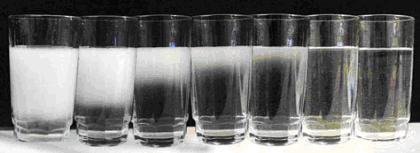We take the quality
of water that we
deliver very seriously.
We are in compliance
with industry
standards for
construction,
operation and
maintenance of
our domestic water
system and abide by
all Federal and
State regulations.
Required monitoring
and testing of the
water is done on a
fixed schedule. Water samples are
taken at multiple
locations around the
system each month
and sent to a State
certified lab
in Montrose for
analysis. A history
of these sample
results is charted
and any deviation
from expected
results is
immediately
investigated by
Tri-County
personnel. Project 7
Water Authority,
located east of
Montrose, treats and
delivers
water for the
majority of the
domestic water
purveyors in the
Uncompahgre Valley
for distribution
to their customers. Any
specific questions
about water
treatment should be
directed to Project
7.Some of the
common water quality
complaints we
receive are listed
below.
White
or cloudy water
Drinking water can
sometimes appear
‘milky’ or ‘cloudy’
when first drawn
from the tap. This
is usually caused by
air and generally
disappears after a
short time.
If your water is
white, milky or
cloudy fill a glass
with water and leave
to stand for a few
minutes. If the
cloudiness clears
from the bottom of
the glass upwards,
this shows the
cloudy appearance
has been caused by
air. The tiny air
bubbles will rise to
the surface and the
cloudy appearance
will disappear. If
the water does not
clear in this way
please contact us.
The effect can be
seen in the image
below.

Cloudy water caused
by tiny air bubbles
in the water is not
harmful to health.
Pink Stains
Pink residue or
stains on household
fixtures is
generally not caused
by the water
delivered to your
home. In fact,
pink residue is
likely a result of
airborne bacteria,
which produce a
pinkish or dark gray
film on regularly
moist surfaces such
as toilet bowls,
showerheads, sink
drains, and tiles.
Some people have
also noted that the
pink residue appears
in their pet's water
bowl.
Many experts agree
that the bacteria
that causes these
pink stains is most
likely Serratia
marcesens, a
bacteria which is
found naturally in
soil, food, and
animals.
Serratia, which
produce a
characteristic red
pigment, thrive on
moisture, dust, and
phosphates and need
almost nothing to
survive. The pinkish
film often appears
during or after
construction or
remodeling, when
dust and dirt
containing
Serratia
bacteria are stirred
up. Once the
bacteria is
airborne, it will
seek a moist
location in which it
can grow. Some
people have reported
that the pink
residue only appears
during certain times
of the year, when
their windows are
left open for most
of the day. Wind
can carry the
airborne bacteria or
stir up dust in
which the bacteria
are present.
The use of activated
carbon filters,
which remove
chlorine from the
water, can make the
problem worse. The
absence of the
normal levels of
chlorine in tap
water allows
Serratia to
thrive.
How do I get
rid of pink residue?
The best solution to
this problem is to
continually clean
the involved
surfaces to keep
them free from
bacteria. Compounds
containing chlorine
work best, but keep
in mind that
abrasive cleaners
may scratch
fixtures, making
them more
susceptible to
bacterial growth.
Chlorine bleach can
be used periodically
to disinfect the
toilet and help to
eliminate the
occurrence of the
pink residue. An
easy way to do this
is to add three to
five tablespoons of
fresh bleach to the
toilet tank, flush
the toilet to allow
the bowl to be
disinfected, and add
another dose of
bleach to the tank
as it is refilling.
The use of toilet
"cakes" containing
disinfectant can
help keep the
problem under
control. By keeping
bathtubs and sinks
wiped down and dry,
the formation of
pink residue can be
easily managed.
Taste Issues
The sense of taste
can vary greatly
from person to
person. Determining
a definite cause can
be difficult. In
our region we are
fortunate to have
high quality
raw water directly from
high elevation snow melt. However
there may be times
when you notice that
the water tastes
'different'. One
possible cause is
water line
replacements.
During such
upgrades we will
install new PVC
waterlines. New
lines are
disinfected and
flushed before being
put into service but
you may still notice
a 'plastic' taste.
This is an
unfortunate side
effect of our
efforts to maintain
the reliability of
the water
distribution system
but the taste will
quickly subside as
water is used.
Naturally, the more
customers using
water from a new
line, the faster the
taste will subside.
Some taste issues
can result from
plumbing or fixture
modifications at the
customer's site such
as water heater
replacements or a
new fixture
requiring
modifications to the
existing supply
lines. Of course,
if the taste issues
persist, feel free
to contact us and we
will try to assist
in determining what
the cause may be.
Additional
Information
Check out these
websites for more
information
pertaining to
drinking water
quality.
The AWWA Meter to
Tap informational
brochure (pdf)
The EPA site on
various drinking
water topics
